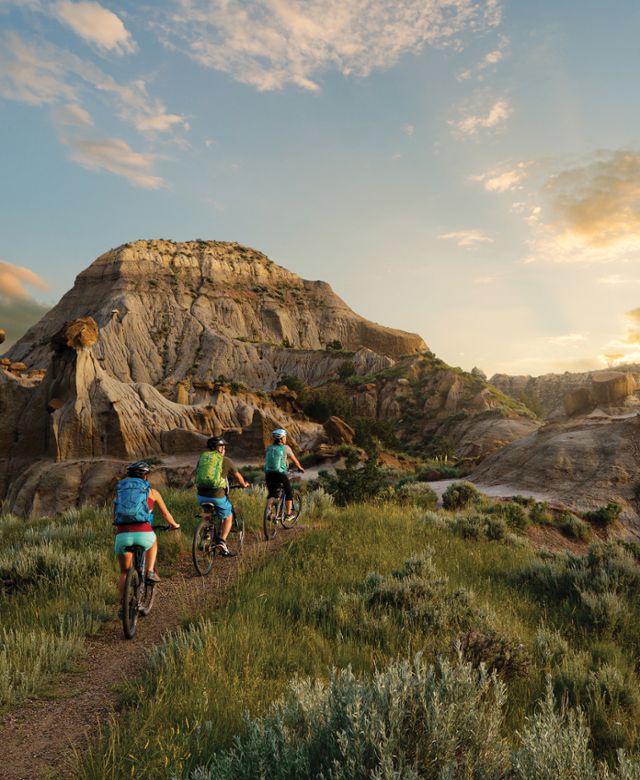
Keep it the last best place
With over 147,000 square miles to explore, our unspoiled beauty, wonderful wildlife and charming small towns deserve respect and thoughtfulness from visitors and residents alike. Montana is called the "Last Best Place," because it truly is. Here's what you can do to help keep it that way.
Trip Details: Seeley Lake > Bitterroot Valley > Big Hole Valley > Jackson Hot Springs > Maverick Mountain > Elkhorn Hot Springs > Bannack State Park > Philipsburg
On this four-day sampler of Montana winter fun, somewhere among the exhilarating snowmobiling and downhill skiing, the cozy cabins and hot springs and the one-of-a-kind sights and welcoming towns, it’ll hit you: You’re having the best winter ever.
To complete this itinerary as designed, you’ll need a snowmobile, cross-country skis, downhill skis and ski poles.

Go With A Plan
Plan Ahead and Be Prepared
Thinking ahead, planning ahead and being prepared leaves more time for exploring and less time for worrying.
- Montana’s weather is as diverse as its landscape. Prepare for changing conditions that could cause floods, fires or other hazards.
- If possible, schedule your trip to avoid times of high visitation. Parking lots in popular areas fill up early and fast. Always have a backup plan in case lots are full.
- Many Montana state and national parks or recreation areas on tribal lands may require reservations, licenses, permits or tags to enter, camp, hunt or fish. Book, purchase, and secure necessary documents months in advance. Research and plan accordingly.
- Check ahead for the availability of water, grey water disposal, gas stations, trash bins, and bathrooms before traveling to remote or rural areas.
- Bring a map or GPS device and know how to use it. Do not rely on cell phones, as service can be spotty or unavailable in many outdoor areas.

STAY ON TRACK
Stick to Designated Trails and Campsites
The paths are where it's at. Staying on trails and in designated campsites keeps nature, wildlife and even you safe!
- Shortcuts and straying from the designated trail can be tempting, but travel in the middle of the trail, even when it's wet and muddy. This protects trailside vegetation, wildlife homes, and archaeological and cultural sites.
- Find a durable surface, such as rock, sand, deep snow or dry grass, to take a break, enjoy the view, or let others pass.
- Check vehicle requirements. Area rules and regulations may prohibit the use of certain types of motorized, and even non-motorized, vehicles on designated trails.
- Respect private property and sovereign tribal lands by staying on designated trails and roads and following signage.
- Allow wildlife access to water and protect sensitive waterside vegetation by camping at least 200 feet (70 big steps) from lakes and streams.
- Camp only in designated or existing campsites. Plan time to locate an appropriate site, and also have a backup plan. Many Montana campsites require a reservation. Plan accordingly.

PACK IT OUT
Dispose of Waste and Trash Properly
As we like to say, pack it in and pack it out. All waste has its proper place, including trash, as well as human and pet waste. Help protect our nature.
- Pack it in, pack it out. Put litter—even fruit peels/cores—in a bag and carry it out.
- Help protect wildlife and others by packing out fishing line and hooks.
- Use bathrooms whenever available. If not available, bury human waste in a hole 6 to 8 inches deep and at least 200 feet (70 big steps) from water, camp, and trails.
- Use a bag to pick up your pet's waste, and pack it out to the nearest available trash can. Pet waste can contain harmful bacteria, and pet food includes ingredients not found locally in nature.
- When bathing or washing dishes, carry water 200 feet away (70 big steps) from streams or lakes and use small amounts of biodegradable soap.

LEAVE IT BE
Leave It As You Find It
From small rocks to historical artifacts and cultural items, everything has a home and purpose in Montana and should be left in its place.
- Protect the cultural and spiritual connections tied to items and places significant to Indian Country. Do not touch or move cultural or historical structures and artifacts.
- Leave rocks, plants and other natural objects as you find them. Even the smallest item can play a big role in the local ecosystem.
- Avoid introducing or transporting invasive insects, plants and aquatic species. Brush off boots and bike tires and clean, drain, and dry all watercraft before and after every outing.
- Treat trees and other plants with respect by not carving into or damaging them. This removes a plant's protective layer, which can harm or kill it.

BE WILDFIRE WISE
Prevent Wildfires and Practice Campfire Safety
Leave no ember behind. It's vital to practice general fire safety and drown out campfires completely.
- Use a camp stove for cooking. Stoves are easier to cook on and create less impact than campfires.
- Wildfires cause lasting impacts to Montana's natural areas. Before your trip, check to see if campfires are allowed in the area you plan to visit.
- Use only existing fire rings and keep your fire small. NEVER leave a fire unattended.
- Buy or gather firewood locally. This prevents the introduction of any invasive species, like the destructive pine beetle.
- When you're done with your fire, burn all the wood to ash and drown out your fire by pouring 3 to 4 gallons of water on it. Drown, stir, drown some more, then feel. Only leave once the ash is cool to the touch.
- Do not smoke in natural areas when fire restrictions are in place. NEVER throw a lit cigarette out of a vehicle or along a trail. Remember to extinguish your cigarette with water.
- Secure vehicle chains, which can cause sparks. Don't let chains or metal from your vehicle drag on the road while you're driving.

KEEP WILDLIFE WILD
Respect Wildlife and Keep Your Distance
There's nothing like witnessing wildlife, but the view is best, and safest for you and them, from a distance.
- Observe wildlife from a distance and never follow or approach them. Not sure how close is too close? Try covering one eye with your hand and stretch your other arm out in front of you with your thumb up. If you can cover the animal with your thumb, you are far enough away!
- Never feed wild animals. Feeding wildlife damages their health, alters natural behaviors, and exposes them to predators and other dangers.
- Montana is home to both black bears and grizzly bears. Keep yourself and bears safe by storing your food, trash and anything with a scent in a locked vehicle or bear canister/bear locker.
- Prepare for bear country by learning how to identify different bear species, packing bear spray, and knowing how to use it.
- Be aware and in control of your pets. Do not allow them to interact with wildlife. Keep them on leash where required. Remember, dogs are not allowed on trails in our national parks.
- Don't disturb wildlife during mating season, while nesting or when with young offspring. Never interact with young (or any) wildlife.

DO YOUR SHARE
Be Considerate — Share Our Open Spaces
Loving Montana means being courteous in our communities and respecting everyone you meet. Thanks for doing your part!
- Respect and be courteous to other visitors and the communities where you're traveling.
- Yield to other users on trails. When passing people on a trail, downhill hikers yield to uphill hikers. Bikers yield to all hikers, and all users yield to equestrians and wheelchairs.
- When passing non-motorized users with your ATV, reduce your speed drastically until you are a good distance from them. This reduces dust in the air and can prevent livestock from being spooked.
- Not every visitor loves our pets as much as we do. Leash your pets and do not allow them to approach other visitors or their pets without permission. Managing your pets will ensure everyone stays safe and enjoys their adventures.
